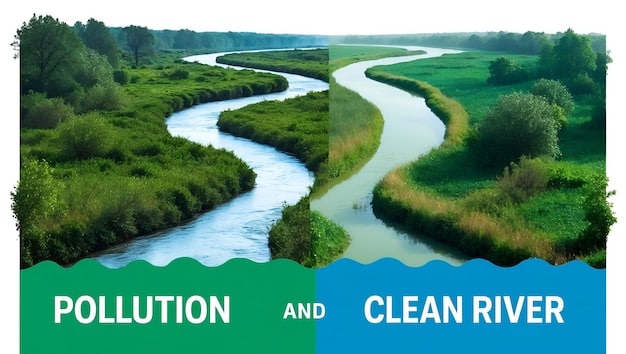Potential Impacts: Environmental Regulation Changes on US Businesses

Proposed changes to environmental regulations can significantly impact businesses and the environment, potentially leading to both economic challenges for companies and varying degrees of environmental protection.
The landscape of environmental regulations is ever-evolving, and proposed changes can create ripple effects throughout the economy and natural world. Understanding what are the potential consequences of the proposed changes to environmental regulations on businesses and the environment is crucial for informed decision-making and strategic planning.
Understanding Proposed Changes to Environmental Regulations
Environmental Regulations are undergoing constant revision to address emerging environmental challenges and technological advancements. Proposed changes can arise from new scientific findings, shifts in societal priorities, or evolving economic conditions.
Understanding these changes is crucial for both businesses and environmental stakeholders as they can impact operating procedures, compliance costs, and the overall health of the environment.
The Regulatory Landscape in the U.S.
In the United States, environmental regulations are primarily governed by federal laws such as the Clean Air Act, the Clean Water Act, and the Endangered Species Act. These laws are implemented and enforced by agencies like the Environmental Protection Agency (EPA). State and local governments also play a role in environmental regulation, often enacting stricter standards or addressing specific regional issues.
Proposed changes to these regulations can stem from various sources, including legislative action, agency rulemaking, or judicial decisions. These changes can involve modifications to existing standards, the introduction of new requirements, or the streamlining of permitting processes.
- Legislative Action: Congress can amend existing environmental laws or enact new ones, leading to significant shifts in the regulatory landscape.
- Agency Rulemaking: The EPA and other agencies can propose and finalize new regulations or modify existing ones through a process that includes public notice and comment.
- Judicial Decisions: Court rulings can interpret environmental laws and regulations, setting precedents and shaping their application.
Staying informed about these proposed changes requires careful monitoring of legislative developments, agency announcements, and court decisions. Businesses and environmental groups often employ lobbyists and legal experts to track these developments and advocate for their interests.
In conclusion, understanding the genesis of proposed changes to environmental regulations is fundamental to assessing their potential impacts on businesses and the environment. This understanding enables stakeholders to engage in informed discussions, anticipate challenges, and proactively adapt to new requirements.
Potential Economic Consequences for Businesses
The implementation of new environmental regulations can have far-reaching economic consequences for businesses. These changes can affect a wide range of industries, from manufacturing and energy to agriculture and transportation.
While environmental regulations are designed to protect the environment and public health, they can also impose costs on businesses, potentially impacting their competitiveness and profitability.

Increased Compliance Costs
One of the most immediate economic consequences of new environmental regulations is the increase in compliance costs. Businesses may need to invest in new technologies, equipment, and processes to meet stricter environmental standards.
These costs can include expenses related to pollution control, waste management, emissions monitoring, and environmental remediation.
- Capital Investments: Businesses may need to invest in new equipment or facilities to comply with regulations related to air or water quality.
- Operating Expenses: Compliance can also increase operating expenses, such as the cost of raw materials, energy, and labor.
- Permitting Fees: Businesses may need to pay fees to obtain permits or licenses required to operate under the new regulations.
The magnitude of these costs can vary depending on the industry, the size of the business, and the stringency of the regulations. Small businesses may be particularly vulnerable, as they often have fewer resources to absorb the costs of compliance.
For example, new regulations on wastewater discharge could require manufacturers to install advanced treatment systems, which can be a significant capital expense. Similarly, stricter emissions standards for vehicles could increase the cost of transportation and logistics.
In conclusion, the economic consequences of new environmental regulations for businesses can be substantial, particularly in terms of increased compliance costs. Businesses need to carefully assess these costs and develop strategies to mitigate their impact on their operations.
Environmental Benefits of Regulatory Changes
Changes to environmental regulations are often implemented with the primary goal of achieving specific environmental benefits. These benefits can range from improved air and water quality to the protection of endangered species and the preservation of natural resources.
While businesses may face economic challenges in complying with new regulations, the environmental benefits can have long-term positive impacts on both human health and ecological systems.
Improved Air and Water Quality
One of the most common environmental benefits of regulatory changes is improved air and water quality. Stricter emissions standards for industrial facilities and vehicles can reduce air pollution, leading to better respiratory health and reduced smog.
Similarly, regulations on wastewater discharge and agricultural runoff can reduce water pollution, protecting aquatic ecosystems and ensuring safe drinking water supplies.
- Reduced Air Pollution: Regulations can limit the release of pollutants such as particulate matter, sulfur dioxide, and nitrogen oxides, improving air quality in urban and industrial areas.
- Cleaner Waterways: Restrictions on the discharge of pollutants into rivers, lakes, and oceans can protect aquatic life and preserve water resources for human use.
- Health Benefits: Improved air and water quality can lead to reduced rates of respiratory illness, cardiovascular disease, and other health problems.
For example, the Clean Air Act has been credited with significant reductions in air pollution since its enactment in 1970. Stricter regulations on vehicle emissions and industrial sources have led to cleaner air in many major cities. Similarly, regulations on wastewater treatment have reduced water pollution in many rivers and lakes, improving aquatic habitats and recreational opportunities.
In conclusion, environmental regulations are often implemented with the express aim of improving environmental quality. Air quality, water quality, and other environmental factors all stand to gain from these changes.

Potential Job Creation vs. Job Losses
One of the most debated aspects of environmental regulations is their potential impact on employment. Proponents argue that new regulations can stimulate job creation in industries related to clean energy, pollution control, and environmental remediation.
Opponents, on the other hand, contend that regulations can lead to job losses in industries that face higher compliance costs or reduced competitiveness.
The Debate Over Employment Impacts
The employment impacts of environmental regulations are complex and can vary depending on the specific regulations, the industry affected, and the overall economic climate. Some studies have shown that environmental regulations can lead to net job losses, particularly in industries that are heavily reliant on fossil fuels.
Other studies have found that environmental regulations can create new jobs in industries such as renewable energy, energy efficiency, and environmental consulting.
- Job Creation: New regulations can drive demand for clean energy technologies, creating jobs in manufacturing, installation, and maintenance.
- Job Losses: Higher compliance costs can lead to reduced profitability and job losses in industries that are heavily reliant on fossil fuels.
- Economic Restructuring: Environmental regulations can accelerate the shift towards a more sustainable economy, creating new opportunities for innovation and entrepreneurship.
For example, regulations that promote the use of renewable energy sources such as solar and wind power can create jobs in the manufacturing, installation, and maintenance of these technologies. However, these regulations may also lead to job losses in the coal mining and oil drilling industries. The net effect on employment depends on the relative size and growth rates of these industries.
In conclusion, environmental regulations, though often environmentally beneficial, can have complex and varied impacts on employment. While job creation is a potential positive outcome, job losses can also occur.
Impact on International Trade and Competitiveness
Environmental regulations can also have implications for international trade and competitiveness. Countries with stricter environmental standards may face higher production costs, which could make their products less competitive in global markets.
However, stricter environmental standards can also lead to innovation and the development of new technologies, which could enhance competitiveness in the long run.
The Global Regulatory Landscape
The impact of environmental regulations on international trade and competitiveness depends on the global regulatory landscape. If all countries adopt similar environmental standards, the impact on competitiveness may be minimal.
However, if some countries have lax environmental standards, they may gain a competitive advantage by producing goods at a lower cost.
- Trade Barriers: Countries may impose trade barriers on goods produced in countries with lax environmental standards, in an effort to promote environmental protection and level the playing field.
- Innovation: Stricter environmental standards can drive innovation and the development of new technologies that can enhance competitiveness in the long run.
- Consumer Preferences: Consumers are increasingly demanding environmentally friendly products, which can create a competitive advantage for companies that adopt sustainable practices.
For example, the European Union has implemented strict environmental regulations and has also imposed trade barriers on goods produced in countries with lax environmental standards. This has encouraged companies to adopt more sustainable practices and has created a competitive advantage for European firms in some sectors.
In conclusion, the ways in which environmental regulations can impact business, whether negative or positive, will depend on a great many factors. These include existing international trading arrangements and consumer preferences.
Strategies for Businesses to Adapt to Changes
Businesses need to develop proactive strategies to adapt to changes in environmental regulations. These strategies can include investing in new technologies, improving energy efficiency, reducing waste, and engaging with policymakers.
By taking a proactive approach, businesses can minimize the costs of compliance and even turn environmental regulations into a competitive advantage.
Proactive Adaptation Strategies
There are several strategies that businesses can use to adapt to changes in environmental regulations. First, businesses can invest in new technologies that reduce pollution and improve resource efficiency.
Second, businesses can implement energy efficiency measures that reduce their energy consumption and greenhouse gas emissions. Third, businesses can reduce waste and recycle materials to minimize their environmental footprint. Fourth, businesses can engage with policymakers and participate in the regulatory process to ensure that their concerns are heard.
- Invest in new technologies: Businesses can invest in new technologies that reduce pollution and improve resource efficiency.
- Improve energy efficiency: Businesses can implement energy efficiency measures that reduce their energy consumption and greenhouse gas emissions.
- Reduce waste: Businesses can reduce waste and recycle materials to minimize their environmental footprint.
For example, a manufacturing company could invest in new equipment that reduces air emissions and water pollution. A transportation company could invest in fuel-efficient vehicles or alternative fuels. A retail company could implement a recycling program and reduce waste in its operations.
In conclusion, successful companies will develop forward-looking and creative strategies to adapt to shifts in environmental regulation. The most adaptable companies are most likely to thrive in the long term.
| Key Aspect | Brief Description |
|---|---|
| 🌱 Environmental Benefits | Improved air and water quality through stricter standards. |
| 💰 Economic Impact | Increased compliance costs for businesses. |
| 💼 Job Market | Potential job creation in green industries, losses in others. |
| 🌍 Global Trade | Impact on competitiveness depending on international standards. |
Frequently Asked Questions
▼
The primary environmental laws in the U.S. include the Clean Air Act, regulating air emissions; the Clean Water Act, governing water pollution; and the Endangered Species Act, protecting threatened and endangered species.
▼
Businesses can reduce compliance costs by investing in energy-efficient technologies, implementing waste reduction and recycling programs, and engaging with regulators to understand and prepare for new requirements.
▼
The Environmental Protection Agency (EPA) is responsible for implementing and enforcing federal environmental laws, setting standards, conducting research, and providing grants to state and local governments.
▼
Environmental regulations can disproportionately affect small businesses due to their limited resources. They often struggle to afford the necessary investments in compliance technologies and processes.
▼
The long-term benefits include improved public health, preservation of natural resources, reduced environmental damage, and increased sustainability, leading to a healthier environment for future generations.
Conclusion
In conclusion, the proposed changes to environmental regulations present a complex interplay of potential consequences. While businesses may face economic challenges in adapting to new requirements, the environment and public health stand to benefit from improved air and water quality, as well as the preservation of natural resources.





